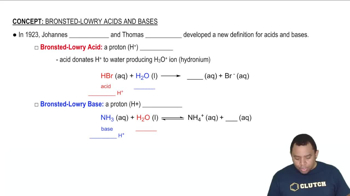Here are the essential concepts you must grasp in order to answer the question correctly.
Acid-Base Theory
Acid-base theory explains how substances can donate or accept protons (H+ ions). Strong acids, like HClO4, completely dissociate in water, increasing H3O+ concentration significantly. In contrast, weak acids or neutral salts do not contribute to H3O+ concentration as effectively, making this theory essential for understanding the behavior of the given substances.
Recommended video:
Bronsted-Lowry Acid-Base Theory
Dissociation of Ionic Compounds
Ionic compounds dissociate into their constituent ions when dissolved in water. For example, Zn(NO3)2 dissociates into Zn²+ and NO3- ions, while Na2O reacts with water to form Na+ and OH- ions. The extent of dissociation and the nature of the ions produced influence the resulting H3O+ concentration in the solution.
Recommended video:
pH and H3O+ Concentration
The pH scale measures the acidity or basicity of a solution, with lower pH values indicating higher H3O+ concentrations. The relationship between pH and H3O+ is logarithmic, meaning that a small change in pH corresponds to a significant change in H3O+ concentration. Understanding this relationship is crucial for arranging the substances based on their H3O+ levels.
Recommended video:
 Verified step by step guidance
Verified step by step guidance

